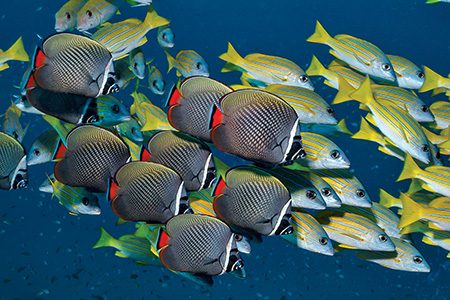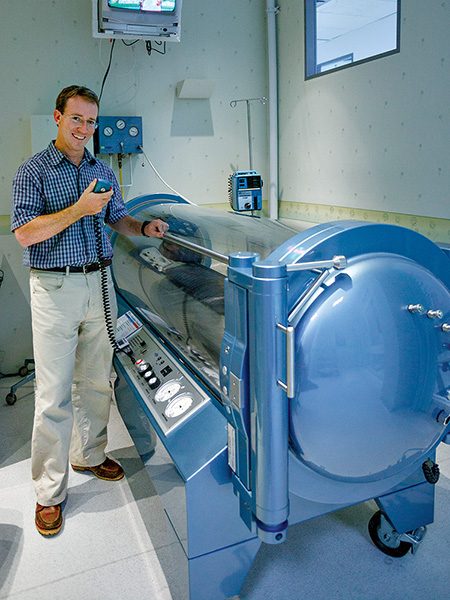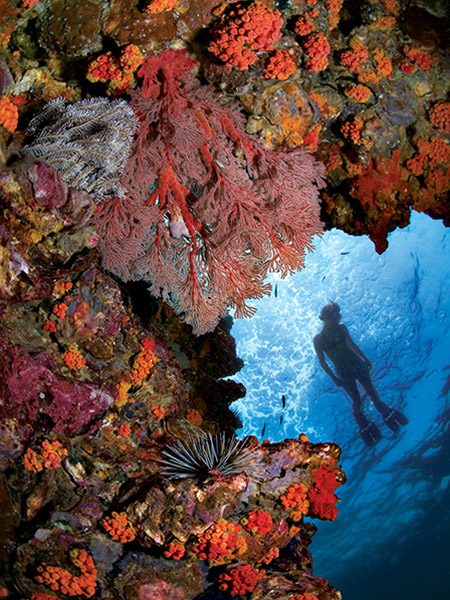It’s odd to be thinking of Benjamin Franklin while in an ambulance driving from the border between Myanmar and Thailand to a recompression chamber in Phuket, but his quote rang in my head that day: “For want of a nail, the shoe was lost. For want of a shoe, the horse was lost. For want of a horse, the rider was lost. For want of a rider, the battle was lost. For want of a battle, the kingdom was lost. And all for the want of a horseshoe nail.” My nail, metaphorically speaking, was a cap for a synch plug on my housing.
It was 2004, the dawn of digital photography, and I was conflicted about whether to shoot film or digital. I had brought housings for both cameras with me to Thailand. Carrying two housings on a dive was ponderous, but I could manage it if I didn’t take two sets of strobes. My solution was to rig both housings with wet connectors called EO pigtails, which went into the regular sync socket, allowing me to connect and disconnect my strobes underwater.
I took off one of the pigtails but accidentally left open the synch port while at Richelieu Rock, one of Thailand’s most iconic dives. My housing wouldn’t flood because of that, but it wouldn’t fire the strobe due to the electrical short circuit from exposure to salt water. That’s the backstory of what went wrong. The real story is how it went wrong and how I could have avoided it.
The dive was outstanding, with lots of fish, soft corals, and remarkable visibility. I shot the film camera first. It took me 15 minutes at 80 feet (24 meters) to run through my 36 frames. When I switched to my digital housing, it wouldn’t fire the strobe because of the flooded synch port. What I should have done, and what would have saved the whole situation, was to be happy with what I had, do my safety stop, and shoot digital on the next dive.
Instead, in my photography-induced addiction I raced to the surface so I could dry out the port, add a new strobe cord, and return to the dive. I thought I could do it quickly before the bubbles in my body figured out the reduced pressure from being back on the surface. That was stupid in retrospect, and I didn’t fool my physiology. I had omitted my decompression obligation and got decompression sickness (DCS) — the bends.

Once it happens, there’s no taking it back. I felt the bubbles lodge in my neck and knew what would happen next. The crew would give me oxygen at the surface and call Divers Alert Network, who would arrange to facilitate my treatment. I’d be evacuated to a recompression chamber and be done diving for the week. This trip was long before I had any affiliation with DAN — I was just another underwater photographer who was too greedy with photo ops. The DAN medic on our satellite phone call had heard it all before and knew exactly what to do.
It was complicated because Richelieu Rock was the last dive before we were scheduled to cross to Myanmar from Thailand. The ambulance crew couldn’t accommodate immigration procedures, so I had to stay on the Thailand side of the border for evacuation to Phuket for treatment while my buddies sailed off for their night dive.
I remember it as a two-hour drive on rough and winding roads, but when I arrived in Phuket I was admitted to a beautifully modern hospital with an acrylic-tube recompression chamber. I had received treatment for DCS before, but it was in a large multiplace chamber in Oahu after a DCS event in Vanuatu. This chamber was far less intimidating. I could lie on my back and watch movies through the chamber’s transparent walls while breathing oxygen at the depth my treatment tables proscribed. I even took pictures of the chamber and my doctor before I climbed in, not knowing I would need the photos 20 years later.
The treatment went well, and many symptoms resolved with a single treatment. They treated me again the next morning for the lingering symptoms. After the treatments I still felt rough, with a compromised gait and tingling in my fingers. Some symptoms will only be cured in time, which is what my doctor advised. I had to take it easy for a while, drink plenty of fluids, and let my body heal from the trauma.


Confident in my recovery, I had to figure out a way to rejoin the boat. I had chartered the liveaboard for a photo tour and wanted to be back on board with my friends, even if I was restricted to snorkeling for a while. They were just crossing back into Thailand after their scheduled three days of diving in Myanmar.
The timing was lucky for me as I was able to hitch a ride in an ambulance returning to the border, but unfortunately it was to evacuate my friend Dennis Liberson, who had been run over by the dive dinghy. The propeller had cut off his fin and badly lacerated his foot, and the hull gave him a massive contusion on his shin.
Regardless of the causation — my stupidity and his misfortune — DAN was there for us in both of our accidents. They arranged and paid for our evacuations and treatments. Liberson spent five days in the hospital and missed his normal flight home, but DAN assisted with his return travel arrangements.
We’ve made scores of trips together since then, and the common thread of our trip preparation has always been to not leave without our cameras and our DAN member cards.
Note: You can read about Liberson’s accident at https://tinyurl.com/prop-accident.
© Alert Diver — Q2 2024